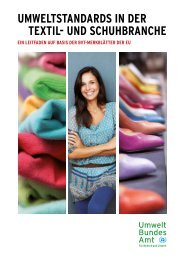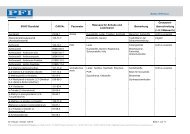Here - PFI Group
Here - PFI Group
Here - PFI Group
You also want an ePaper? Increase the reach of your titles
YUMPU automatically turns print PDFs into web optimized ePapers that Google loves.
Which Shoelace<br />
is Suitable for Which Shoe?<br />
Or more fittingly: What must a shoelace be able to<br />
endure and what should it look like? These are in<br />
fact the principal aspects determining the proper<br />
choice:<br />
Since professional, work, safety, or hiking footwear<br />
has to withstand substantially greater stresses than<br />
lightweight leisure shoes, the laces clearly have to<br />
cope with more stringent demands. <strong>Here</strong> it is recommended<br />
to use thick, robust, high tensile strength<br />
laces made of synthetic fibres. Ideally, they should<br />
also have a round cross section because they can then<br />
accommodate a core at their centre – as described in<br />
this article – which enhances their strength. Shoelaces<br />
made in this way resist abrasion and withstand<br />
high tensile forces better than flat laces made of<br />
cotton. Anybody who has tried their hand at mountaineering<br />
will certainly appreciate the importance<br />
of strong laces and the security of firmly laced-up<br />
footgear.<br />
Casual leisure footwear or seasonal goods which just<br />
happen to be in fashion are subject to far less stress.<br />
Imagination knows no bounds with regard to material,<br />
colour, and production method. Even shoes with<br />
zip fasteners may have additional laces. Their original<br />
purpose as a means of closing a shoe no longer<br />
plays any role. The laces merely serve as decoration.<br />
The visual appearance and the colour of laces and<br />
the way in which they are tied have been playing an<br />
ever-greater role in recent years. There are even web<br />
pages devoted to the art of lace tying, which present<br />
a wealth of extraordinary and quirky ways of lacing<br />
shoes – just try googling “tying shoelaces”!<br />
01.2011<br />
Magazine of the Test and Research Institute Pirmasens<br />
In the sports sector, flat, flexible, and extensible<br />
laces have proved their value for running shoes because<br />
they are not so stiff as thick round laces. The<br />
elasticity of such shoelaces also assures a firmer fit<br />
of the shoes. Moreover, knots in such laces do not<br />
come undone so quickly. This distinct practical advantage<br />
predestines the flat variants for use in children’s<br />
shoes: fewer undone shoelaces mean fewer<br />
tumbles.<br />
There can be many reasons for shoelaces coming undone:<br />
On the one hand, the choice of material plays<br />
an importance role. If it is fairly rough it will offer<br />
more resistance to opening of knots and bows. On<br />
the other hand, the thickness and structure of the<br />
laces (density of braiding) will have an effect on their<br />
stiffness. The more inflexible the laces, the easier the<br />
carefully laced-up shoe will come undone. In addition<br />
to starting material and method of production,<br />
substances applied to the material in the course of<br />
production also play an important role. They may<br />
influence not only the roughness but also the flexibility<br />
of the laces. There is currently no standard<br />
test proceedure for assessing how readily shoelaces<br />
come undone during wear or which laces have superior<br />
properties in this respect compared to competing<br />
products. However, <strong>PFI</strong> does undertake a test<br />
to estimate the probability that a knot will come<br />
undone, paying due attention to structure, stiffness,<br />
and frictional properties of laces and material.<br />
On no account should we forget the kind of footwear<br />
which has to meet particularly stringent demands,<br />
such as firefighter boots. These have to withstand<br />
heat and fire and should clearly never catch<br />
alight. They therefore contain a certain amount of<br />
fire retardants.<br />
37
















